Cecilia Lindqvist 林西莉 (1932–2021), M.A., sinologist, author, pedagogue, photographer and musician, was one of the most prominent experts on Chinese culture, history, language, society and popular life in Sweden. For decades she wrote articles and books, held lectures and taught in senior high schools and universities. Throughout the years, she received numerous awards, and in 1989, she was awarded with the title of Professor of Honour by the Swedish government for her cultural contributions. From 2003 she held a three-year guest professorship at Beijing Language and Culture University.
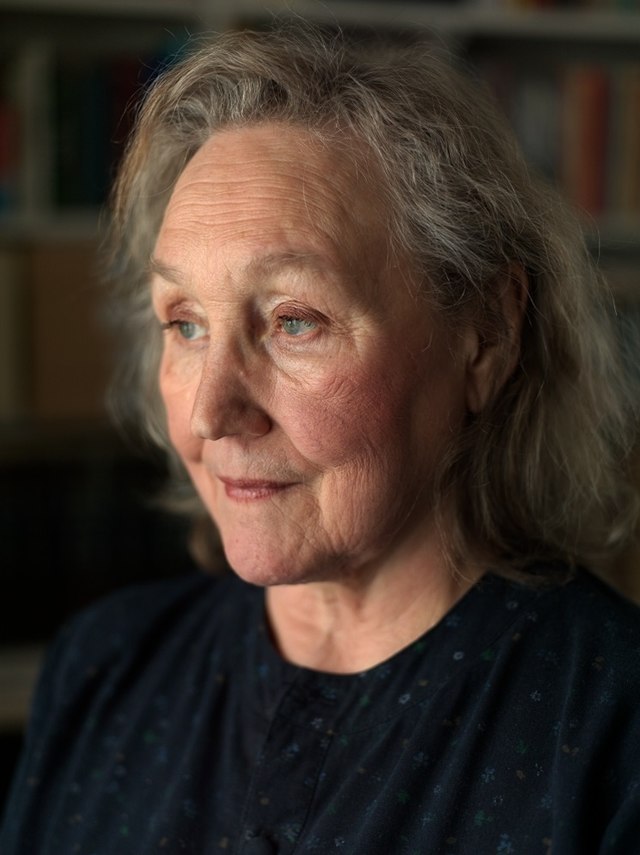
Photo: Per Myrehed
The first time Mrs. Lindqvist encountered the Chinese people and its culture was in 1961, when she and her husband the author Sven Lindqvist decided to travel to Beijing for studies in Chinese at Beijing University. Until this point their view of China was formed by language researchers, archaeologists and adventurers such as Bernhard Karlgren – the father of Swedish sinology – Johan Gunnar Andersson, Osvald Sirén, Sven Hedin and the missionaries in China that every seventh year returned home to Sweden reporting about their experiences. Engaged in their work, Cecilia’s parents often received homecoming missionaries in their house. Mrs. Lindqvist therefore heard many stories from China as a child. This was before 1949. After that, fewer reports would reach Sweden, so in spite of the Chinese studies for Bernhard Karlgren, the China which the Lindqvist couple arrived to was completely unknown to them.
The Lindqvists studied Chinese and lived in a room at Beijing University in the district of Haidian, which at that time was merely a village next to the countryside. In addition to the Chinese classes, Mrs. Lindqvist was enlisted as a student at the Research Institute of Qin. This encounter with the ancient string instrument guqin was a life-changing experience for her. The Institute started in 1952 with the support from Zhou Enlai in accordance with the idea “make the past serve the present”. The intention was to make an inventory of the collections of guqin instruments in monasteries, temples and private homes throughout the country. Another purpose was to collect and make transcriptions of all known compositions written for guqin since the 7th century. In addition, 262 pieces performed by 86 guqin players were recorded during this time. The researchers and musicians working at the institute had a profound and living knowledge of the Chinese cultural heritage. Mrs. Lindqvist was deeply affected by their perseverance and steady dedication in their work to document the ancient cultural heritage and convey it into a new era. It came to alter her life forever. Later she wrote: “I intensively felt that I also wanted to live and work so devotedly”. And so she truly did.
Music had been a fundamental part of Mrs. Lindqvist’s life since childhood. At the age of five, she started to play the piano for Mr. Baranowski – former concert pianist at the symphony orchestra in St. Petersburg – which she loved in spite of the archaic format. The family lived in the university town of Lund in the south of Sweden, where Mr. Baranowski had started a small music school after leaving Russia in the 30’s. When her family later moved to Stockholm she continued to take piano lessons. Every Wednesday she went to magnificent piano concerts at the Concert Association in Stockholm. However, after ten years she started to feel unhappy playing the piano, finding the Viennese classical era and even more Stravinsky, Prokofiev and Shostakovich somewhat too masculine, aggressive and assertive for her taste. Therefore she started to play the Renaissance lute beside the piano studies – “an adorable instrument with twenty sinew strings” she said – giving space for more playfulness and intimacy. From 1958 to 1959, she went to Germany and then to the Italian city Siena to study lute with her brother Johan.
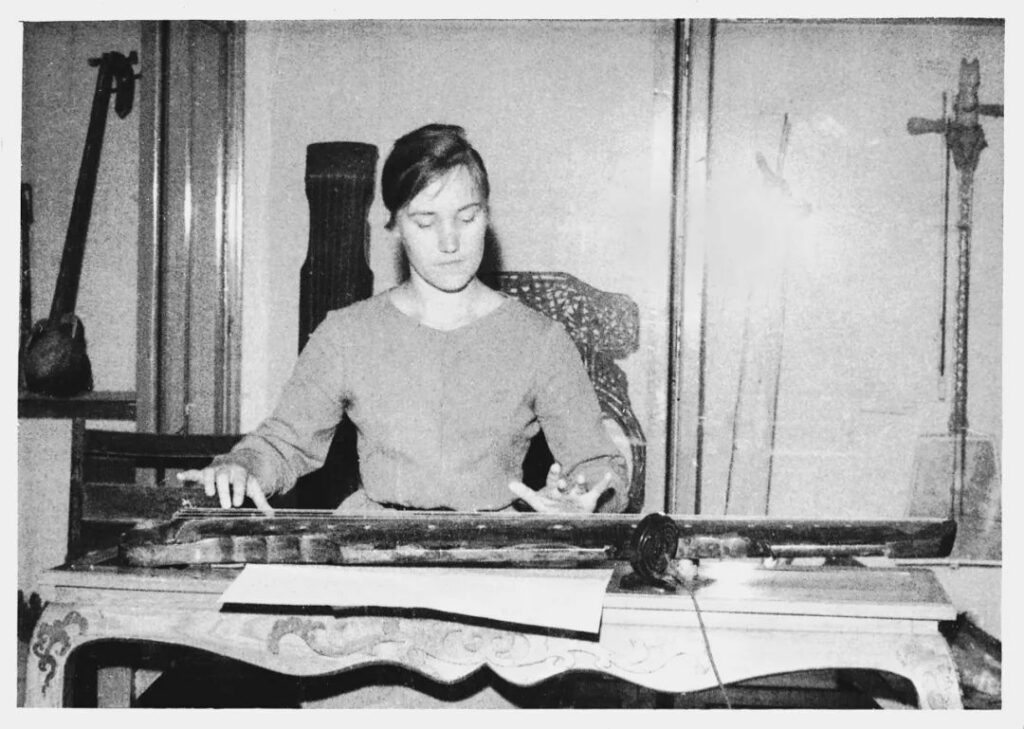
Mrs. Lindqvist playing the guqin at the Research Institute of Qin, 1961
Initially, Mrs. Lindqvist’s intention was to learn the Chinese pipa which had resemblance to the European lute, but upon the advice of a Russian music professor in Moscow, whom she met on her way to Beijing with the Transsibirian Railway, she decided to study guqin. Unaware of the fact that qin was not taught in regular courses, but strictly handed over from master to pupil, she paid a visit to the Research Institute of Qin, asking for a course. At first they refused her request, but when she asked if they could find a teacher for her, they promised to see what they could do. One week after she was enlisted as pupil for Mrs. Wang Di, enrolled as the first and only student ever at this Institute. For two years Mrs. Lindqvist played guqin for Mrs. Wang Di, slowly becoming friends for life.
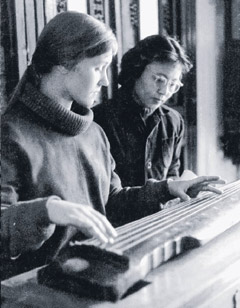
Mrs. Lindqvist with Mrs. Wang Di
Finally Mrs. Lindqvist had found the expression she so intensively had longed for. She writes in her book Qin “The music I encountered at the Institute was simultaneously gentle and forceful, sincere and intimate, but more like a conversation between two close friends or a meditation, rather than brilliant manifestation in a concert hall, and the magically floating tones of the silk strings went straight into my heart”.
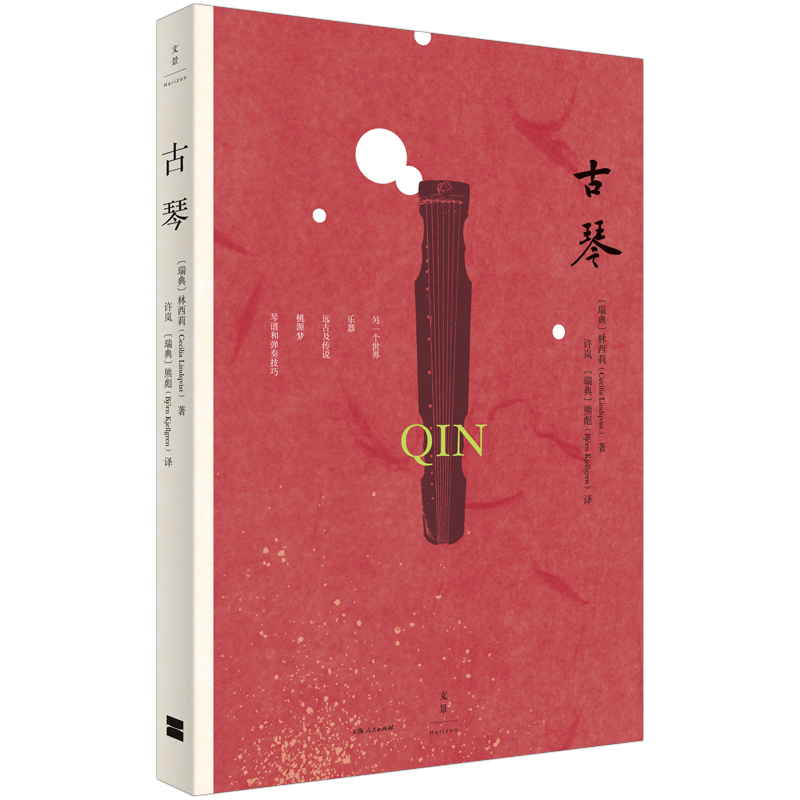
The book Qin, Chinese version
The Lindqvist couple depicted their experiences from 1961 to 1962 in their book China from the Inside. After this period followed 6 months of travelling through India in their own car, a voyage they continued through Pakistan, Afghanistan, Iran, Iraq, Turkey, resulting in their book Asian Experience. Back home, Mrs. Lindqvist started teaching at Norra Real senior high school in Stockholm. They had their first child, Aron, and in 1967 and 1968, when he was barely three years old, they went to Latin America to write reports for the Swedish Daily Dagens Nyheter. They drove all over the continent – in the same Volvo they had previously used for their journeys in Asia. Mrs. Lindqvist had just written her Master’s Thesis at Stockholm University on the origin of language and became increasingly interested in her son’s language development and reactions on the Latin American reality. These studies resulted in her first own book Travelling with Aron.
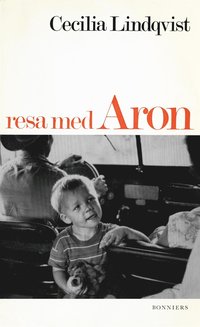
Travelling with Aron, Swedish version
In 1970, Clara, their second child, was born, and three years later Mrs. Lindqvist returned to China, which had changed a lot in these ten years. In the 80’s, she once again lived in Beijing with her family for a two-year period and continued to visit China one or several times every year for the rest of her life, for travels and research, often meeting Wang Di. After Wang Di’s death in 2005, the lifelong friendship continued with her two daughters Deng Ying and especially Deng Hong who had become a skilled guqin player like her mother. In 2007-2011, Mrs. Lindqvist arranged tours around Sweden with more than 40 overfilled concerts together with Deng Hong and a great flute player, Chen Shasha.
Mrs. Lindqvist mastered the art of storytelling. She captivated and fascinated her audience as an author, a lecturer and as a teacher, weather the subject was grammar, the origin of Chinese characters, rural women’s situation or ancient string instruments. There was always room for small ingenious details and funny detours. In the classroom at Södra Latin senior high school where Mrs. Lindqvist taught for many years, she would use her body language when describing the four phonetic tones in the Chinese language, moving not just her hands but her whole body to illustrate how the tone runs from top to bottom or falls in a deep valley. This was a great help to consolidate the learning and she knew it. As students we didn’t consider it much, but she was uttermost pedagogical. It became even more clear when she later taught us Chinese Literature at the University; her classes were relievingly vivid and interesting as always.
Mrs. Lindqvist’s long career as a teacher began in the autumn of 1960 when she taught history and Swedish at the senior high school, after studies in art history, history, Nordic languages and literary history. Ten years later, she managed to get permission to teach Chinese at Skanstull senior high school – for the first time in Sweden. In 1982, Chinese was finally recognized as a third language at all senior high schools.
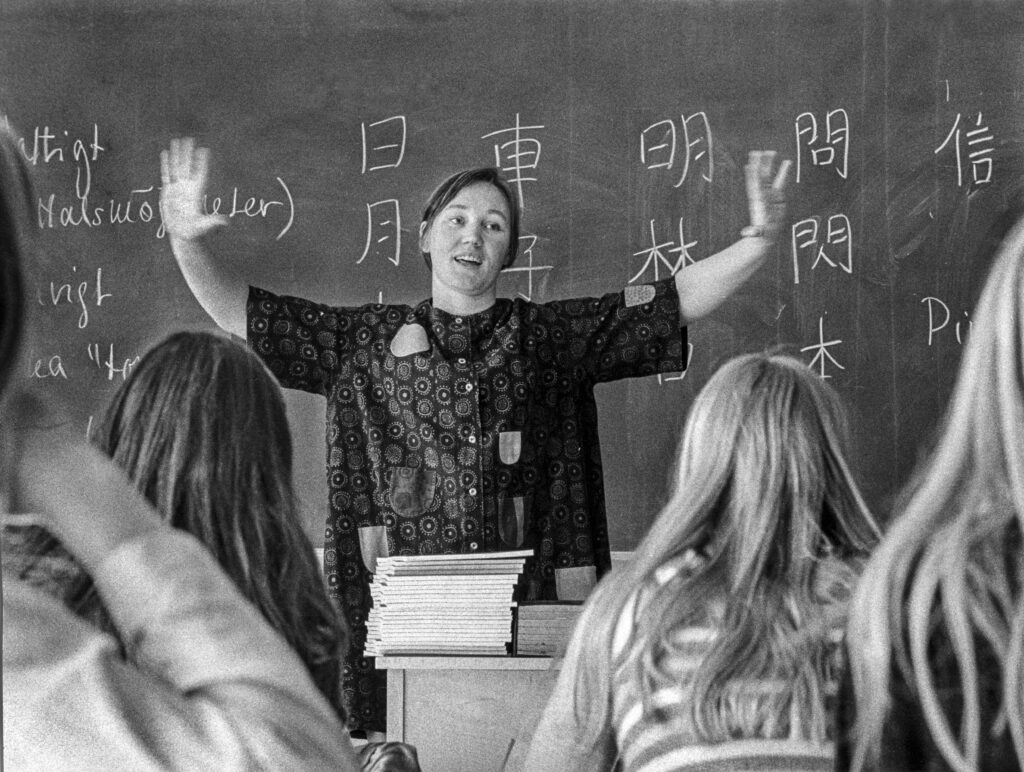
Mrs. Lindqvist in 1971 at Skanstull senior high school
Everything was integrated in her lessons; the characters were linked to the history of tea, grammar and folk music – she knew how to weave together China’s long, multifaceted cultural history into one comprehensible net of concepts, contextualizing the different parts without losing the complexity.
Having experiences from Latin America, Middle East, India and South Europe, in addition to her profound knowledge in European cultural history, she had the ability to put China’s situation and development in a global framework.
With every new character we learned, Mrs. Lindqvist also depicted its original forms and development to the shape of today, placing it in a cultural-historical or everyday context. She put much effort into each student, making everyone feel seen and encouraged. I believe that not so few studied Chinese just because they loved her classes and many times she aroused an interest that might not necessarily have been there otherwise. Her curiosity and dedication were easily transmitted, as was her courage. With a great interest in ordinary people’s everyday lives, she was engaged in how living conditions affected and were shaped by changes in societies in general. In the 1980’s she made a series of documentaries for the Swedish Television, Woman in the Middle Kingdom, depicting northern rural women in the New China. At home in Sweden she later in life continued to find time for engagements; gathering list of signatures and participating in meetings concerning reckless constructions, closures or demolitions and she once told me they had created a broad network of activist neighbors in her area.
From 1994 to 2004, Mrs. Lindqvist was the chairman of the Swedish-Chinese Friendship Association, and also deeply involved in its periodical China Report. It was in this context that Mrs. Christina Nygren, writer and researcher in popular theatre, came to know Mrs. Lindqvist.
“We have been friends for twenty-five years by now, at least,” Mrs. Nygren says. “I think it started just after my book Ghosts, Generals and Elusive Goddesses came out. It was about popular theatre in Northern China. Cecilia contacted me and asked if I wanted to write about it for the China Report.” From then on, the two of them became friends and colleagues, and Mrs. Lindqvist nominated her for the Association board, and later she became the editor of the China Report. They were both interested in popular and regional theatre with a faiblesse for Shanxi and Shaanxi provinces. They worked together to prepare for a guest performance of Songs from the Yellow Mountains – Mrs. Lindqvist had initiated the project and asked Mrs. Nygren to do the organizational work. Mrs. Nygren ended up not only organizing but also travelling with the artists making the introduction at every performance.
Mrs. Lindqvist was deeply fascinated by the Chinese silhouette art form of paper cuts. She made a lot of research and several long journeys, during which she gathered a large collection of paper cuts made by skilled female cutters in the Shanxi and Shaanxi countryside and the desert areas close to the Great Wall. The peasant women in these areas have practiced this art for millennia, cutting beautiful decorations in paper to embellish their simple homes dug into the loose sandstone of the mountainsides. She intended to edit the material into a book but did not have the time before she fell too ill. Two years ago, Mrs. Nygren persuaded her to write an article on Chinese paper cuts for Fokus Kina (the new name of China Report). “Cecilia had a real treasure trove of paper cuts, I do hope that somebody will continue the work that she has begun,” Mrs. Nygren says mournfully.
“Cecilia was a very interesting person, combining strictness with humour,” she continues. “She was unbelievably strict with herself, never sloppy or hasty. When something was to be published, she would sit by the printer’s side to check that every letter or character was in its correct place. She was meticulous in her professional work and careful in all tasks, be it research or cooking – by the way, she was an excellent cook and she often brought a little something, boiled or pickled, to the meetings in the Friendship Association.”
Mrs. Clara Norman, Mrs. Lindqvist daughter, points out: “One important thing not really mentioned in articles about her is that to her, everything was a matter of creation. There were no borders, all tasks being equally important – garden work, playing mahjong, educational work or art – everything was connected. My mother’s lifetime achievement started when she began to teach Chinese in senior high school. The educational task was a precondition for all the rest, that’s where she flourished and found herself and gathered strength. She took her pupils to her heart and became immensely important to them. She could sit many evenings with a student who had problems or needed guidance, and many of her former students became her friends for life.”
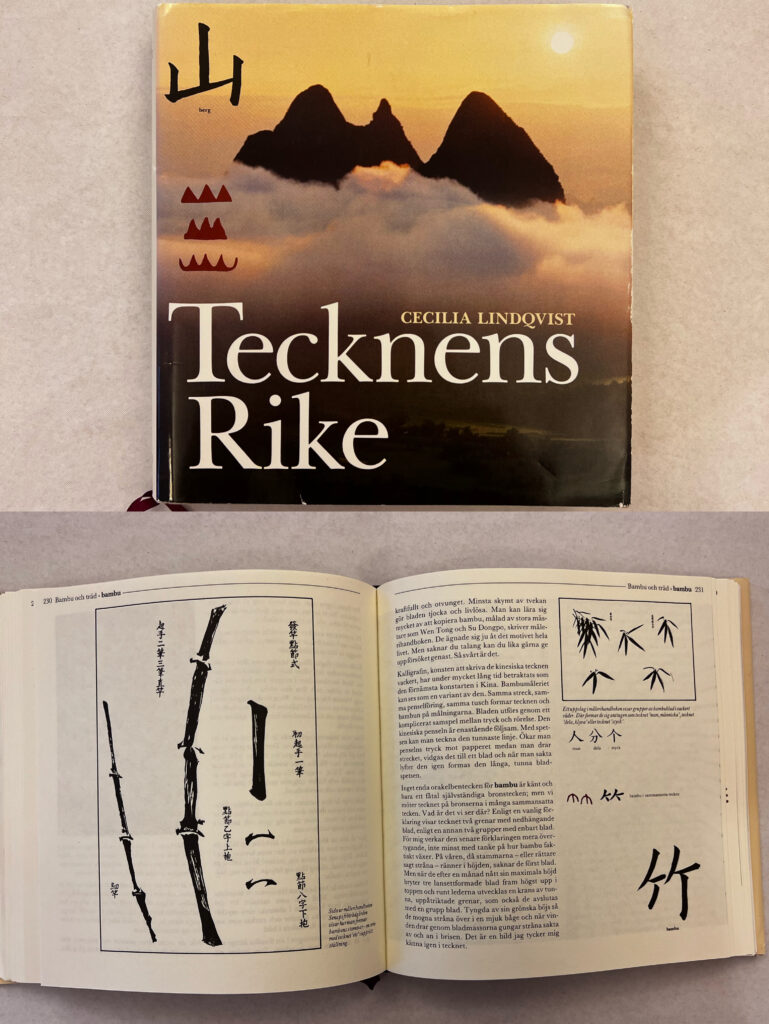
China: Empire of Living Symbols, Swedish version
China: Empire of Living Symbols, which explains why Chinese characters look like they do, is without doubt Mrs. Lindqvist’s most important book. Her deep interest in this topic was first aroused by Bernhard Karlgren, the first foreigner to explore the inscriptions on oracle bones and ancient bronzes, but it was in the interplay with the many questions her students asked that the book took form.
In an interview made by the Swedish Authors’ Association she says: “I worked on this book for fifteen years and during this time I did not only read about but lived in the Chinese civilization in all its aspects – a gigantic, always captivating work which became a way of life. Year after year, I traveled to new archaeological sites in China, searched for and visited experts within all the different areas I described, and the more I learned, the more questions I found to delve deeper into. Human and animal life, nature, architecture, music, philosophy – everything! I got decisive help from the many new archaeological findings from the period when the characters took shape in the 1st millennium BC. My book is the first in the world to discuss and explain the central character repository in the light of this extensive archaeological material.”
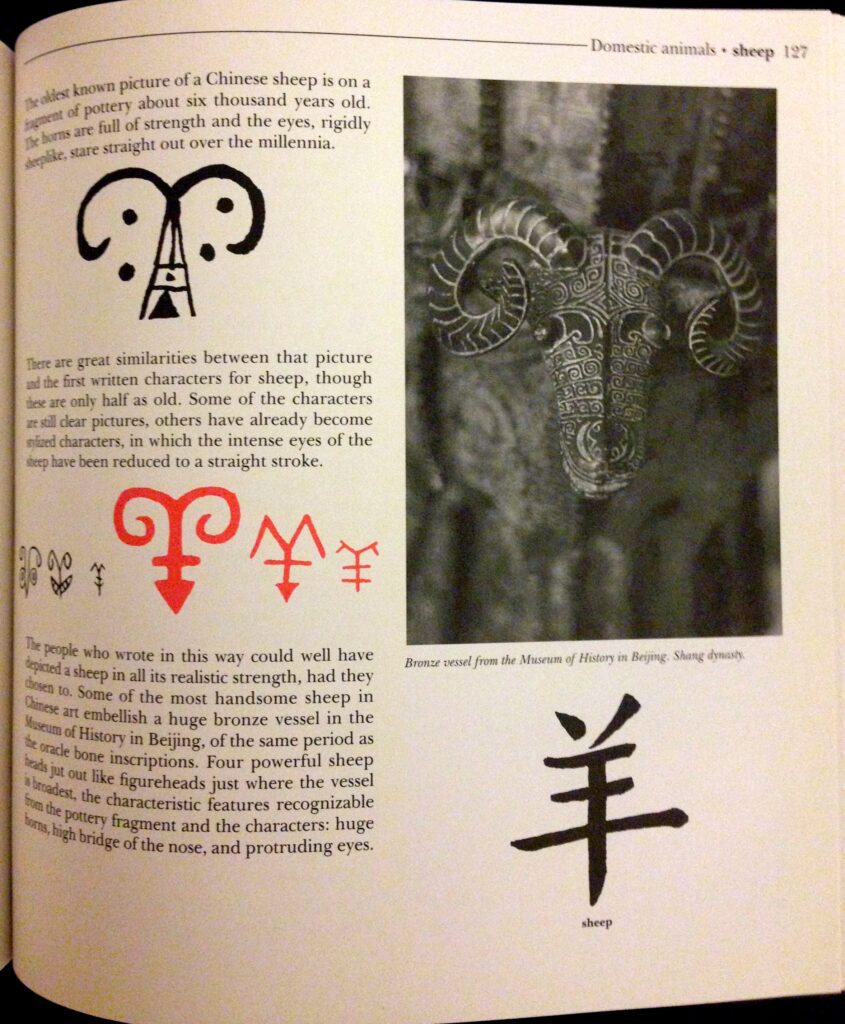
China: Empire of Living Symbols, English version
When the book was published in 1989, it received a very positive response both in Sweden and in the rest of the world. Translated into 14 languages it was awarded the August Prize (given to the finest books of the year in Sweden) the same autumn and was published in Chinese in 1999, translated by Mrs. Lindqvist’s old friend Professor Li Zhiyi who has also translated Astrid Lindgren and August Strindberg into Chinese. China: Empire of Living Symbols has sold in enormous numbers both on the mainland and in Taiwan and has for a long time served as a textbook for Chinese universities as well as supplementary reading for senior high schools. In a period of three years beginning in 2003, Mrs. Lindqvist was invited as a guest professor at Beijing Language and Culture University. Her task was to lecture on her findings concerning the origin of Chinese characters both to Chinese language students and to Chinese teachers at the language schools for foreign students in China. In 2016, a version of this book adapted for students in the ages of 10 to 15 years was published in China, and simultaneously the Chinese translation of Another World, Mrs. Lindqvist’s last book, describing the years 1961-62 in Beijing. For these two occasions, she traveled to China for the last time to receive the very prestigious prize “The Special Book Award of China”.
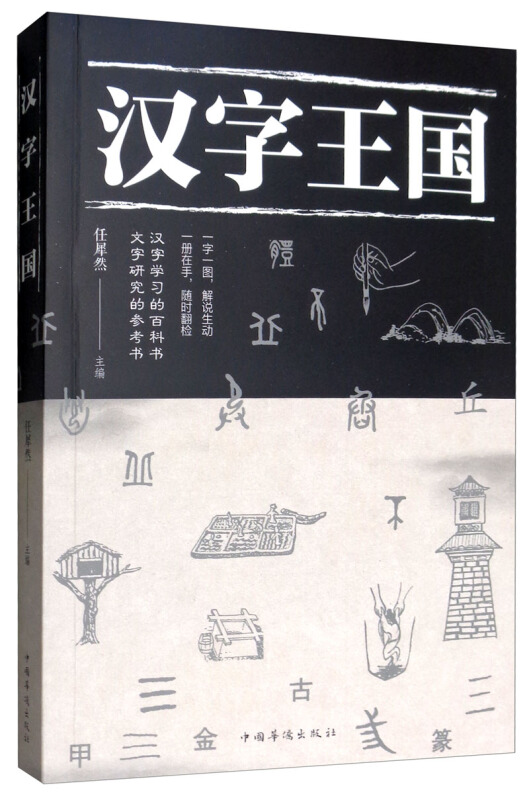
China: Empire of Living Symbols, Chinese version
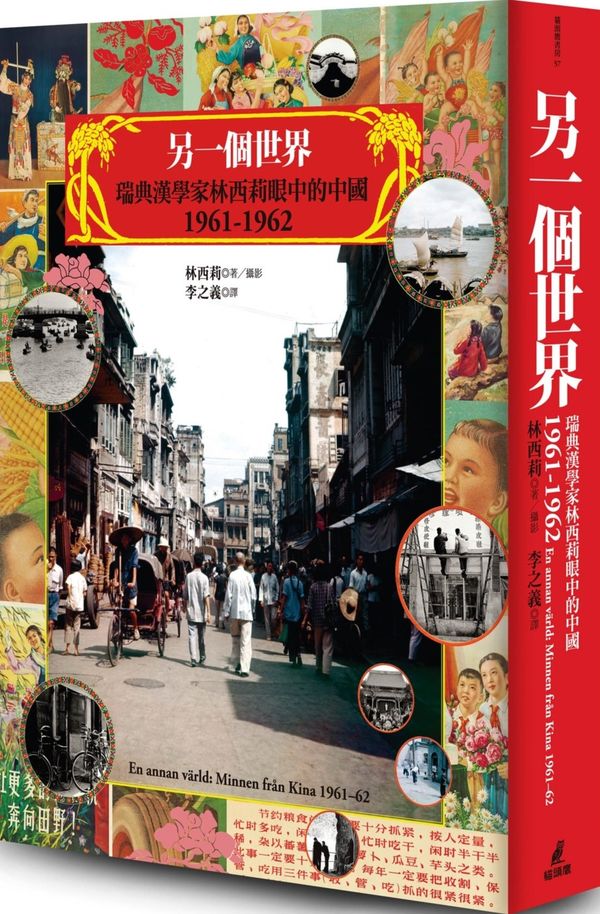
Another World,Chinese version
One of Mrs. Lindqvist’s main cultural contributions consists of bringing to life a multifaceted image of China. With great insight and passion, she presented its complexity in an understandable way, spreading knowledge of China to the general public. She lived a long and rich life and made countless friends all over the world. We are many who miss her.
Written by: Maria Nordsø Lundberg, Mrs. Lindqvist’s former student and Artistic Advisor at China Cultural Center in Stockholm
Facebook: China Cultural Center in Stockholm
https://www.facebook.com/China-Cultural-Center-in-Stockholm-110983273921638
Instagram: chinaculturalcenterinstockholm
https://www.instagram.com/chinaculturalcenterinstockholm/
Youtube: China Cultural Center in Stockholm
https://www.youtube.com/channel/UCYqOYwuQtyTHC-iMNdfExsw
Tik Tok: cccinstockholm
@cccinstockholm
地址/Address:
Västra Trädgårdsgatan 2, Stockholm


